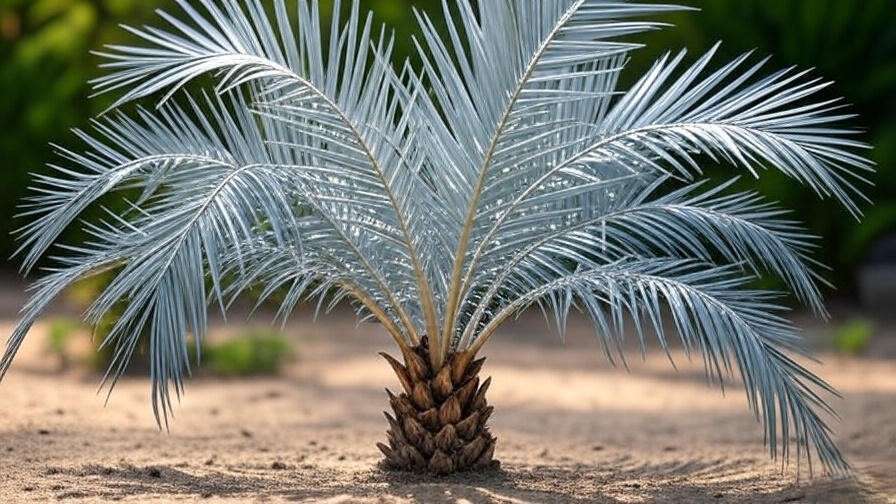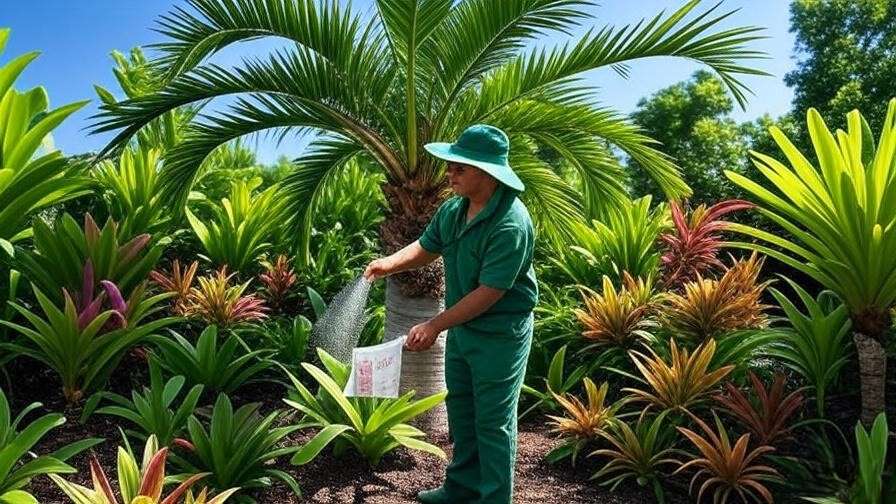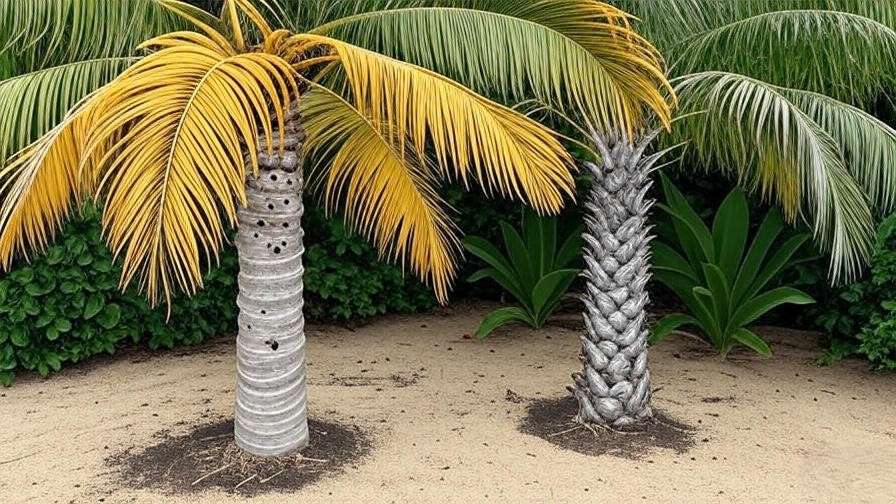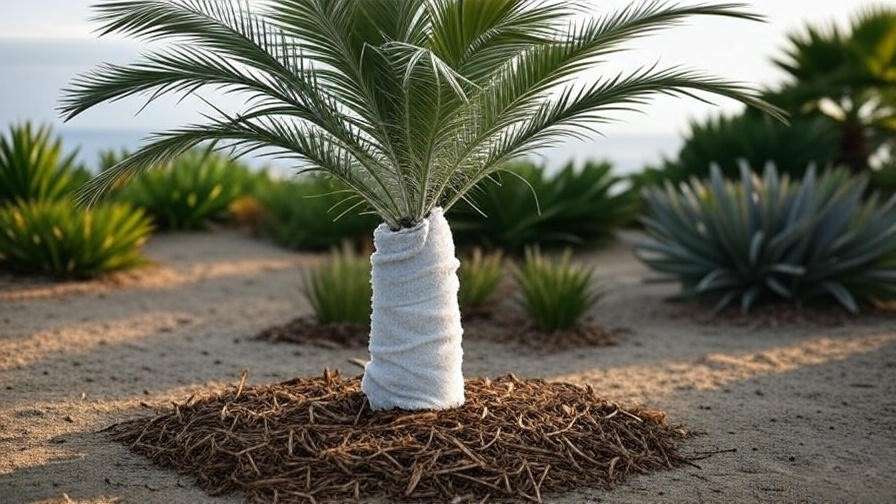Imagine transforming your garden into a tropical oasis with the shimmering, silvery-blue fronds of a silver palm tree swaying gently in the breeze. The silver palm tree (Coccothrinax argentata), with its compact size and low-maintenance charm, is the perfect addition for plant enthusiasts seeking exotic beauty without the hassle. Whether you’re a seasoned gardener or a beginner dreaming of a coastal vibe, this guide will empower you to grow a thriving silver palm tree that becomes the centerpiece of your landscape. Drawing on horticultural expertise and years of hands-on plant care experience, we’ll walk you through every step—from planting to pest control—to ensure your silver palm flourishes. Ready to create a stunning tropical retreat? Let’s dive in! 🌞
1. What Is a Silver Palm Tree? 🌟
1.1 Overview of the Silver Palm Tree (Coccothrinax argentata)
The silver palm tree, scientifically known as Coccothrinax argentata, is a small, slow-growing palm native to Florida, the Bahamas, and parts of the Caribbean. Its most striking feature is its fan-shaped, silvery-blue leaves that reflect sunlight, creating a dazzling effect in any garden. Typically reaching heights of 8–20 feet, this palm is ideal for small yards, coastal landscapes, or even container gardening. Its resilience to salt spray and drought makes it a favorite for seaside properties, while its elegant appearance appeals to anyone craving a touch of the tropics.

1.2 Benefits of Growing a Silver Palm Tree
Why choose a silver palm tree? Beyond its aesthetic appeal, this palm offers practical benefits. Its shimmering foliage adds a unique, luxurious vibe to landscapes, making it a natural focal point. Environmentally, silver palms support local ecosystems by providing habitat for birds and small wildlife. Their low-maintenance nature means less work for busy gardeners, and their drought tolerance makes them a sustainable choice for water-conscious regions. Whether you’re enhancing a tropical garden or creating a coastal retreat, the silver palm delivers beauty and functionality.
Expert Insight: “The silver palm’s compact size and striking foliage make it a standout for sustainable landscaping in warm climates,” says Dr. Maria Lopez, a horticulturist with the University of Florida’s Extension Program.
2. Choosing the Right Location for Your Silver Palm Tree 🌞
2.1 Ideal Climate and Hardiness Zones
Silver palm trees thrive in USDA hardiness zones 9–11, where temperatures rarely dip below 20°F (-6°C). Native to warm, coastal regions, they’re well-suited to subtropical and tropical climates. If you live in a marginal zone (e.g., zone 8), you’ll need to take extra precautions during cold snaps, which we’ll cover later. Their tolerance for salt spray and windy conditions makes them perfect for beachfront properties or coastal gardens.
2.2 Sunlight and Soil Requirements
To achieve those iconic silvery fronds, your silver palm tree needs the right environment. It prefers full sun but can tolerate partial shade, making it versatile for various garden setups. Aim for at least 6 hours of direct sunlight daily for optimal growth. Soil-wise, silver palms thrive in well-draining, sandy soils with a slightly acidic to neutral pH (6.0–7.0). Heavy clay or waterlogged soils can lead to root rot, so test your soil’s drainage before planting. If drainage is poor, amend the soil with sand or organic matter like compost.
Pro Tip: Use a simple drainage test—dig a 12-inch hole, fill it with water, and ensure it drains within a few hours to confirm your soil is silver palm-ready! 🧪
3. Planting Your Silver Palm Tree: Step-by-Step Guide 🌱
3.1 When and Where to Plant
The best time to plant a silver palm tree is in spring or early summer, when warm temperatures promote root establishment. Choose a location with ample sunlight and enough space for the palm’s mature size (up to 10 feet wide). If planting multiple palms, space them 6–10 feet apart to allow for airflow and growth. Opt for nursery-grown palms for faster establishment, as seed-grown palms can take years to mature.

3.2 Planting Process
- Dig the Hole: Create a hole twice as wide and as deep as the root ball.
- Prepare the Soil: Mix native soil with sand or compost to improve drainage.
- Position the Palm: Place the root ball in the hole, ensuring the top sits level with the ground.
- Backfill and Water: Fill the hole, gently tamping the soil, and water thoroughly to settle the roots.
- Mulch: Apply a 2–3-inch layer of organic mulch (e.g., bark or wood chips) around the base, keeping it away from the trunk to prevent rot.
Example: Sarah, a coastal Florida gardener, planted her silver palm in a sunny corner of her backyard. By following these steps and choosing a well-draining spot, her palm thrived within months, becoming a stunning focal point.
4. Essential Care Tips for a Thriving Silver Palm Tree 🌴
4.1 Watering Needs
Proper watering is key to a healthy silver palm tree. For newly planted palms, water daily for the first 2–3 weeks to establish roots, then reduce to once or twice weekly, depending on rainfall. Mature palms are drought-tolerant and need watering only during prolonged dry spells. Aim for deep, infrequent watering to encourage strong roots. Overwatering can cause yellowing fronds or root rot, while underwatering may lead to browning tips. Check the soil’s moisture level— it should be moist but not soggy.

4.2 Fertilizing for Optimal Growth
Silver palms benefit from regular fertilization to maintain their vibrant foliage. Use a slow-release, palm-specific fertilizer with an 8-2-12 or 10-10-10 NPK ratio. Apply every 3–4 months during the growing season (spring and summer). Avoid over-fertilizing, as excess nutrients can burn roots and cause frond discoloration. For eco-conscious gardeners, organic options like fish emulsion or composted manure work well. Always water thoroughly after fertilizing to help nutrients reach the roots.
4.3 Pruning and Maintenance
Pruning silver palms is minimal but important for aesthetics and health. Remove only dead, brown fronds using clean, sharp pruning shears to prevent disease spread. Avoid cutting green fronds, as this can stress the palm. Clean the trunk periodically by gently removing loose fibers for a tidy appearance. Over-pruning or “hurricane cutting” (removing too many fronds) can weaken the palm, so stick to minimal trimming.
Quick Tip: Sterilize your pruning tools with rubbing alcohol to keep your silver palm disease-free! ✂️
5. Protecting Your Silver Palm Tree from Pests and Diseases 🐞
5.1 Common Pests
Silver palm trees are relatively hardy, but they can attract a few pests. Common culprits include:
- Palm Weevils: These beetles bore into the trunk, causing significant damage. Look for wilting fronds or small holes in the trunk.
- Spider Mites: These tiny pests cause stippling or yellowing on leaves, especially in dry conditions.
- Scale Insects: Small, waxy bumps on fronds or stems indicate scale infestations, which can weaken the palm.
Control Methods: For organic solutions, use neem oil or insecticidal soap, applied early in the morning or late evening to avoid leaf burn. For severe infestations, consult a local extension service for chemical options, but always follow label instructions to protect pollinators. Regular inspections and maintaining plant vigor can prevent most pest issues.

5.2 Diseases to Watch For
Fungal diseases like bud rot (caused by Phytophthora or other fungi) are the primary concern for silver palms. Symptoms include wilting new growth, blackened bud tissue, or a foul odor. Overwatering or poor drainage often triggers this disease. To prevent it:
- Ensure proper spacing for airflow.
- Avoid overhead watering to keep the crown dry.
- Remove and destroy affected fronds immediately to prevent spread.
If bud rot is suspected, apply a copper-based fungicide as a preventive measure after consulting a professional. Healthy palms with proper care are less susceptible to diseases.
5.3 Environmental Stressors
Silver palms are tough, but they can face environmental challenges:
- Cold Snaps: In marginal zones (e.g., USDA zone 8), protect your palm during frost with burlap wraps or frost cloth. Move potted palms indoors if possible.
- Wind Damage: Coastal winds can fray fronds. Plant in a sheltered location or use windbreaks like hedges to minimize damage.
Expert Insight: A 2023 study by the University of Miami’s Department of Botany found that proper spacing and drainage reduced disease incidence in silver palms by up to 40%, highlighting the importance of proactive care.
6. Troubleshooting Common Silver Palm Tree Problems 🛠️
6.1 Yellowing or Browning Fronds
Yellowing or browning fronds are common issues with silver palms, often caused by:
- Nutrient Deficiencies: Lack of potassium or magnesium can cause yellowing. Use a palm-specific fertilizer to correct this.
- Overwatering: Soggy soil leads to root rot and yellow fronds. Check drainage and reduce watering frequency.
- Underwatering: Dry, brown tips signal insufficient water. Increase watering slightly and ensure deep soaking.
Solution: Test soil nutrient levels with a kit and adjust fertilization. Improve drainage with sand or gravel if needed. Monitor watering to find the right balance.
6.2 Slow Growth or Stunted Development
If your silver palm isn’t growing as expected, consider:
- Root Issues: Compacted or damaged roots can stunt growth. Inspect the root ball during planting and avoid over-tamping soil.
- Poor Soil Conditions: Nutrient-poor or heavy soils hinder development. Amend with organic matter or relocate to a better-draining spot.
Solution: Aerate the soil around the palm’s base and apply a balanced fertilizer. If growth doesn’t improve, consult a local arborist to rule out root-bound issues.
Pro Tip: Keep a care journal to track watering, fertilizing, and growth patterns. This helps identify problems early and keeps your silver palm on track! 📝
7. Enhancing Your Landscape with Silver Palm Trees 🌺
7.1 Design Ideas for Home Gardens
Silver palm trees are versatile for landscaping. Their compact size and striking foliage make them ideal as:
- Focal Points: Plant a single silver palm in a sunny corner to draw the eye.
- Groupings: Cluster 3–5 palms for a lush, tropical effect.
- Companion Plants: Pair with low-growing plants like bromeliads, agaves, or bird-of-paradise for a vibrant tropical garden.
For a cohesive look, surround the palm with decorative rocks or mulch to mimic its native coastal habitat.

7.2 Container Gardening with Silver Palms
Silver palms thrive in containers, making them perfect for patios, balconies, or indoor spaces. Choose a large pot (at least 15 gallons) with drainage holes. Use a well-draining potting mix with sand or perlite. Water sparingly, as potted palms dry out faster than ground-planted ones. Indoors, place near a south-facing window for ample light. Rotate the pot monthly to ensure even growth.
Example: Lisa, a Miami apartment dweller, grew a silver palm in a terracotta pot on her balcony. By following a strict watering schedule and using a palm fertilizer, her palm became a stunning conversation piece.
8. Seasonal Care Calendar for Silver Palm Trees 📅
To keep your silver palm thriving year-round, follow this seasonal care guide:
- Spring: Apply fertilizer and inspect for pests. Prune dead fronds to encourage new growth.
- Summer: Monitor water needs during hot, dry periods. Check for spider mites in high heat.
- Fall: Reduce watering as temperatures cool. Prepare for frost in marginal zones by gathering protective materials.
- Winter: Protect from cold snaps with frost cloth or mulch. Water sparingly, as growth slows.
Quick Tip: Set calendar reminders for seasonal tasks to stay on top of your silver palm’s care! ⏰

9. FAQs About Silver Palm Tree Care ❓
- How fast do silver palm trees grow? Silver palms are slow growers, typically adding 6–12 inches per year. Patience is key!
- Can silver palms survive indoors? Yes, in bright, indirect light with proper care, though they prefer outdoor conditions.
- What’s the best way to protect my silver palm from storms? Stake young palms and plant in sheltered areas to reduce wind damage.
- Are silver palm trees safe for pets? Yes, they’re non-toxic to cats and dogs, but discourage chewing to avoid frond damage.
- How do I know if my silver palm is healthy? Look for vibrant, silvery fronds, steady growth, and no signs of pests or yellowing.
Note: These FAQs are based on common questions from gardening forums and social media groups like Reddit’s r/PlantCare and X gardening communities.
10. Conclusion: Your Journey to a Stunning Silver Palm Tree 🌟
Growing a thriving silver palm tree is within your reach with the right care and attention. From choosing the perfect sunny spot to mastering watering and fertilization, this guide has equipped you with expert tips to ensure your palm’s silvery fronds shine for years to come. Whether you’re enhancing a coastal garden or adding tropical flair to a container, the silver palm’s beauty and resilience make it a rewarding choice. Start your journey today, and share your silver palm success stories in the comments below! 🌴
Call-to-Action: Love tropical plants? Explore our related articles on caring for coconut palms or creating a sustainable garden. Have questions? Drop them below, and let’s grow together!













